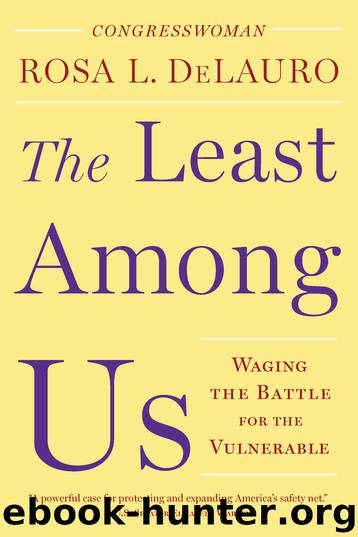The Least Among Us by Rosa L. DeLauro

Author:Rosa L. DeLauro
Language: eng
Format: epub
ISBN: 9781620972212
Publisher: The New Press
Published: 2017-05-04T16:00:00+00:00
9
In Defense Of Children
A family, like a house, can withstand only as much wind and weather as its construction and maintenance allow; the storms that rage around the poor would test the resilience of any structure.
—David K. Shipler, The Working Poor: Invisible in America
THE UNITED STATES HAS TWO tax credits that together lift more children out of poverty than any other federal government policy. They are the Earned Income Tax Credit (EITC) and the Child Tax Credit (CTC). The Earned Income Tax Credit was enacted in 1975, and expanded in 1986, 1990, 1993, and 2001. As a cursory glance at those dates tells you, both Democratic and Republican administrations have championed it, because it is effective and because it uses the tax code, rather than creating new programs. In 2010, the Census Bureau reported that 5.4 million people had been lifted above the poverty line thanks to the EITC and CTC together.
One can also argue that programs like these tax credits are hallmarks of advanced democracies; similar programs exist in the United Kingdom, Canada, New Zealand, the Netherlands, Belgium, Denmark, Sweden, Finland, France, and Austria.
The mechanism for receiving either the Earned Income Tax Credit or the Child Tax Credit is not complicated: if you have earnings, you file a tax return and receive a credit back based on the amount of your earnings and the number of kids under seventeen you have. The credit rises along with your earned income until a set limit, then phases out at higher income levels. The CTC phases out at a much higher income level than the EITC, allowing families to keep their tax credits as their earnings rise well into the middle class. Wealthier families do not qualify for the CTC, as they presumably have sufficient resources to take care of their families’ needs. Yet many low-income families are left out, too, since eligibility is based in part on a family’s earnings, not need.
The fight over the Child Tax Credit has been different from others because the biggest obstacle has not been lies or obstructionism or direct opposition, but indifference to the condition of children, particularly poor children. In the past many Republicans felt the CTC was the right thing to do to buttress both families and family values, and it was effective. Most Democrats liked the program. Still, overcoming the general attitude that improving the CTC was not worth losing political capital kept it in the background for many years, despite the fact that it constitutes a real opportunity to lift people out of poverty. The Child Tax Credit ought to be a flagship issue for both parties and the country.
Why? The United States is exceptional in the extent to which it does not invest in children. Today, approximately a sixth of American children live in poverty and two-fifths live in low-income households. Child poverty rates in the United States are high compared to other countries.1 That is not merely because we have a lot of kids born into single-parent homes; our poverty rate for dual-earner families is high, too.
Download
This site does not store any files on its server. We only index and link to content provided by other sites. Please contact the content providers to delete copyright contents if any and email us, we'll remove relevant links or contents immediately.
| Anarchism | Communism & Socialism |
| Conservatism & Liberalism | Democracy |
| Fascism | Libertarianism |
| Nationalism | Radicalism |
| Utopian |
The Secret History by Donna Tartt(16606)
The Social Justice Warrior Handbook by Lisa De Pasquale(11485)
Thirteen Reasons Why by Jay Asher(7780)
This Is How You Lose Her by Junot Diaz(5753)
Weapons of Math Destruction by Cathy O'Neil(5029)
Zero to One by Peter Thiel(4816)
The Myth of the Strong Leader by Archie Brown(4785)
Promise Me, Dad by Joe Biden(4440)
Stone's Rules by Roger Stone(4412)
Beartown by Fredrik Backman(4403)
How Democracies Die by Steven Levitsky & Daniel Ziblatt(4392)
The Fire Next Time by James Baldwin(4336)
100 Deadly Skills by Clint Emerson(4070)
A Higher Loyalty: Truth, Lies, and Leadership by James Comey(4024)
Rise and Kill First by Ronen Bergman(4008)
The David Icke Guide to the Global Conspiracy (and how to end it) by David Icke(3875)
The Farm by Tom Rob Smith(3869)
Secrecy World by Jake Bernstein(3773)
The Doomsday Machine by Daniel Ellsberg(3725)
